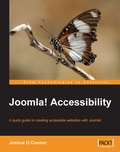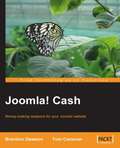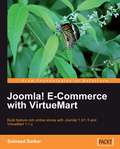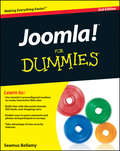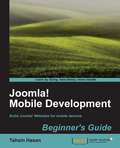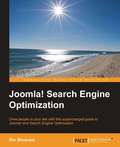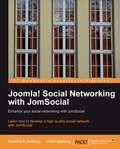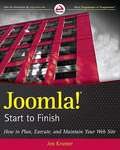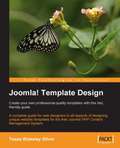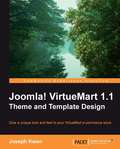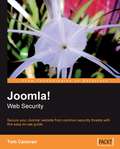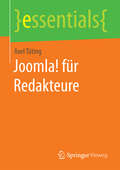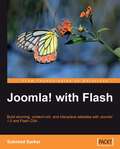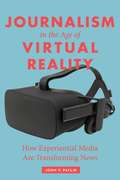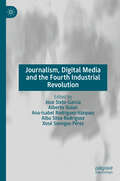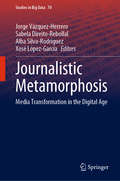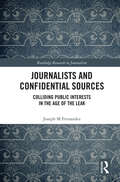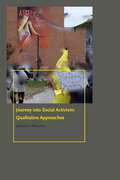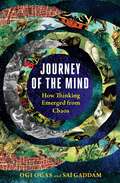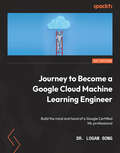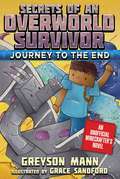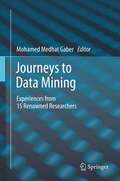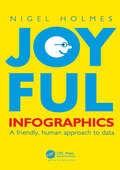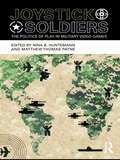- Table View
- List View
Joomla! Accessibility
by Joshue O ConnorThis is a practical book that contains many step-by-step examples for the reader to get their teeth into. Primarily, the book is designed to help the reader gain a deeper understanding of Joomla! and accessibility, but it can also be read as an introduction to assistive technology, disability, and the diversity of user requirements. The book also attempts to de-mystify accessibility and take it off the theoretical platform and firmly root it in the real world with tangible benefits for users of Joomla!. This book is a guide to any Joomla! user who wants to make their sites more accessible and the author does assume that you have a basic working knowledge of Joomla!. You don't need to know anything about accessibility -- the author tells you all that you need to know to make your Joomla! sites accessible to the widest audience. While some design skills and technical knowledge of HTML, CSS and PHP will be very useful you will still benefit from reading this book if you wish to understand more about assistive technology and the needs of people with disabilities. The book is distilled from years of hands on experience that the author has as a web developer and also working with people with disabilities.
Joomla! Bible (Bible #814)
by Ric ShrevesYour complete guide to the Joomla! content management system Whether you use Joomla! to power a website, intranet, or blog, you'll need a good how-to reference on this complex, but not always intuitive, content management software. Joomla! Bible, Second Edition is that book. It not only brings you up to speed on the changes and extensions that are now part of Joomla! 3.0, it thoroughly covers functions and tasks, including installation, configuration, management, advanced modules, and extended coverage of two key extensions. You'll learn how to obtain code and deploy it to a server; how to obtain, modify, and delete content; how to choose between the Joomla! Platform and the Joomla! CMS; and more. By the time you finish the Joomla! Bible, Second Edition, you'll be well prepared to build and maintain a Joomla!-based website. Walks you through obtaining the Joomla! 3.0 code and how to deploy it to a server, configure the site, create content, and manage content and user hierarchies Helps you get the most out of core modules that provide advanced functionality, including the Polls Module, the Banner Manager, Content Syndication, Newsfeed Aggregation, and others Includes hands-on tutorials and real-world practical applications Whether you're a content manager, website manager, developer, or do-it-yourselfer, make sure you keep Joomla! Bible, Second Edition on hand.
Joomla! Cash
by Tom Canavan Brandon DawsonThis book is a fast and easy read, taking the reader from the inception of an idea, to a fully working cash-generating website built on Joomla! This book is suitable for business people with a medium level of technical skill who need a good primer on how to implement a cash-generating website. Those unfamiliar with Joomla! Would benefit from reading Building Websites with Joomla! 1.5 Beta 1.
Joomla! E-Commerce with VirtueMart
by Suhreed SarkarThis is a step-by-step tutorial-style guide, which teaches you to build an e-commerce site through a complete practical example. Are you a Joomla! user who wants to build an e-commerce store? Do you have a Joomla! site and want to add e-commerce to it to sell products? Then this book is for you! The pre-requisites are simple. You should already know how to build a site with Joomla!, have a smattering of CSS/HTML and perhaps some PHP.
Joomla! For Dummies
by Steven Holzner Seamus BellamyBuild template-based web sites without the hassle of writing code!Joomla! is a free, open source PHP & MySQL-based content management system that allows you to create interactive, community-based Web sites without having to write or program code in PHP or ASP.NET. This fun and friendly introduction to Joomla! shows you how to create a rich, interactive Web site that does not require any code.No matter your skill level, this easy-to-understand resource demonstrates how to drop preconfigured modules that already contain PHP and MySQL code directly into your Joomla! site. Thanks to the Dummies fun and friendly approach, you'll quickly see how easy to create a rich, interactive Web site with Joomla!Demonstrates how to create a business site--complete with shopping cart--quickly and easilyWalks you through developing Web sites with discussions, RSS feeds, picture submissions, and moreIncludes coverage of the newest version of Joomla!, explains its completely new administrative features, and reviews its ability to provide different levels of access to different users via much-requested access control listsFind out why Joomla! is the easiest way to build an interactive, community-based Web site!
Joomla! Mobile Development Beginner’s Guide
by Tahsin HasanThis is a practical step-by-step Beginner's Guide to Joomla! mobile website building, with friendly and clear explanations enriched with screenshots for easy and quick comprehension. If you want to build and maintain your own website for mobile visitors, the Joomla! Mobile Development Beginner's Guide is perfect for you. It helps you build on the skills and knowledge you may already have on creating websites--but even if you're new to this subject, you won't have any difficulty understanding the clear and friendly instructions and explanations. You learn how to build and maintain websites for mobile devices without having to dive deep into HTML and CSS.
Joomla! Search Engine Optimization
by Ric ShrevesThe book will take a hands-on approach to the process involved in configuring a site for SEO. As SEO is an ongoing process - it doesn't stop once the site is built - the book will provide reusable tips and techniques in order to understand what they have to do after the site is live,This book targets site builders, webmasters and site owners. Advanced technical skills are not required, though the user should be familiar with administering a Joomla! website, including how to install Extensions.
Joomla! Social Networking with JomSocial
by Beatrice A. Boateng Kwasi BoatengA practical guide, this book provides step-by-step instructions for building your social networking system, showcasing real-world examples throughout. This book is for individuals or institutions desiring to develop a social networking system using the Joomla! content management system. It is suitable for both the novice and the advanced Joomla! user. There is no need for scripting or programming knowledge. All that is required is enthusiasm and the determination to implement a project.
Joomla! Start to Finish
by Jen KramerEverything you need to know to plan and maintain a Joomla! site Joomla! offers powerful functionality and ease of configuration, making it an immensely popular open source content management system. However, far more than simply downloading and installing Joomla! is required in order to create a dynamic web site. This book walks you through the critical steps that must be taken in the planning process prior to establishing a Joomla! site. Joomla! expert Jen Kramer reviews essential questions that need to be asked of a client, discusses technical solutions to a variety of challenges, and explains how a site structure should be organized. Topics Covered: I Want a Web Site and I Want It Blue - How Much Will That Cost? Choosing the Right Technologies to Solve the Business Problem Downloading and Installing Joomla! A Brief Tour of the Joomla! Administration Interface Creating and Configuring Menus Installing and Configuring Modules That Come with Joomla Components That Come with Joomla! Plug-Ins That Come with Joomla! Adding Extensions to Joomla! Home Page Tips and Tricks Custom Templates Advanced Template and CSS Tricks Site Maintenance and Training Once the groundwork has been laid, you'll discover how to host and install Joomla!, and upgrade and maintain your Joomla! site. Note: CD-ROM/DVD and other supplementary materials are not included as part of eBook file.
Joomla! Template Design: Create your own professional-quality templates with this fast, friendly guide
by Tessa Blakeley SilverThis book is aimed at web designers who want to create their own unique templates for Joomla!. Readers should have basic knowledge of Joomla! (which can be obtained by working through Building Websites with Joomla!) and also some knowledge of CSS and HTML, and using Dreamweaver for coding purposes.
Joomla! VirtueMart 1.1 Theme and Template Design
by Joseph KwanThis book is a step-by-step tutorial that will teach you to customize VirtueMart templates and themes. It includes all the essential screenshots and code with exhaustive explanations accompanied by exercises to ensure good pickup.You may be the owner of a Joomla! VirtueMart web store or a designer working with Joomla! VirtueMart. If you want to customize VirtueMart to unleash its enormous potential and elevate your store to the next level, this book is for you. You must have some experience with VirtueMart and understand its basic features. You also need to know HTML and should be comfortable taking up some challenges in PHP and JavaScript programming.
Joomla! Web Security
by Tom CanavanThis book will give you a strong, hands-on approach to security. It starts out with the most basic of considerations such as choosing the right hosting sites then moves quickly into securing the Joomla! site and servers. This is a security handbook for Joomla! sites. It is an easy-to-use guide that will take you step by step into the world of secured websites. This book is a must-read for anyone seriously using Joomla! for any kind of business, ranging from small retailers to larger businesses. With this book they will be able to secure their sites, understand the attackers, and more, without the drudging task of looking up in forums, only to be flamed, or not even find the answers. Prior knowledge of Joomla! is expected but no prior knowledge of securing websites is needed for this book. The reader will gain a moderate to strong level of knowledge on strengthening their sites against hackers.
Joomla! für Redakteure (essentials)
by Axel TütingDieses essential bietet speziell Redakteuren einen Einstieg in das Content Management System Joomla!. Losgelöst vom „Ballast“ der zahlreichen Einstellungen und Möglichkeiten, die in anderen Büchern thematisiert werden, wendet sich dieses Buch ausschließlich an die eigentlichen Endnutzer des Systems und konzentriert sich dabei auf das Schreiben und Veröffentlichen von Beiträgen. Der erfahrene Autor und Joomla!-Kenner Axel Tüting erklärt jeden Schritt praxisnah und verständlich.
Joomla! with Flash
by Suhreed SarkarThis book is a fast-paced step-by step-guide. It is loaded with examples and lots of illustrations showing configurations and their results on the screen. If you are a Joomla! web developer who wants to integrate Flash into your web sites, then this book is for you. Knowledge of Joomla! and basic knowledge of Flash is assumed.
Journalism in the Age of Virtual Reality: How Experiential Media Are Transforming News
by John PavlikWith the advent of the internet and handheld or wearable media systems that plunge the user into 360º video, augmented—or virtual reality—technology is changing how stories are told and created. In this book, John V. Pavlik argues that a new form of mediated communication has emerged: experiential news. Experiential media delivers not just news stories but also news experiences, in which the consumer engages news as a participant or virtual eyewitness in immersive, multisensory, and interactive narratives.Pavlik describes and analyzes new tools and approaches that allow journalists to tell stories that go beyond text and image. He delves into developing forms such as virtual reality, haptic technologies, interactive documentaries, and drone media, presenting the principles of how to design and frame a story using these techniques. Pavlik warns that although experiential news can heighten user engagement and increase understanding, it may also fuel the transformation of fake news into artificial realities, and he discusses the standards of ethics and accuracy needed to build public trust in journalism in the age of virtual reality. Journalism in the Age of Virtual Reality offers important lessons for practitioners seeking to produce quality experiential news and those interested in the ethical considerations that experiential media raise for journalism and the public.
Journalism, Digital Media and the Fourth Industrial Revolution
by Alba Silva-Rodríguez José Sixto-García Alberto Quian Ana-Isabel Rodríguez-Vázquez Xosé Soengas-PérezThe Fourth Industrial Revolution, also known as Industry 4.0, is the fourth most important industrial stage that has occurred since the beginning of the Industrial Revolution in the 18th century. This new revolution is characterized by combining cutting-edge production techniques with intelligent systems that integrate with organizations and people. Communication and journalism, especially digital media, face the challenge of integrating emerging technologies and practices or in-test or developing technologies into companies and communicative products, that are breaking down the boundaries between physical, digital, and biological. This collection analyzes and reflects on the impact of Industry 4.0 on journalism and digital media. The collection is split into three parts. The first part analyzes the emergence of centralized and decentralized networks and their impact on digital media. Specifically, it delves into the role of cryptographic journalism and the impactof free and collaborative networks in the fediverse to fight against disinformation and censorship, as well as to promote data and metadata journalism. In a second part, the "innovation of innovation" is explored with the aim of continuing to create products that satisfy the needs of 4.0 audiences. This is where the challenges and opportunities offered by the metaverse, content automation technologies, the impact of the Internet of Things on journalism, labs, the application of R+D+I to journalism, and collaborative encounters between journalists to develop highly innovative proposals are explored. Finally, in the third part of the book, the emergence of new communicative and journalistic actors in the 4.0 context is reviewed. Examples include start-ups, spin-offs or other entrepreneurial initiatives, communication of knowledge transfer, new financing models, and outsourcing of tasks, new proposals for newsgames, or the impact of artificial intelligence in journalism practices. In addition, a final chapter is dedicated to exploring the new professional skills needed for journalists in this Fourth Industrial Revolution.
Journalistic Metamorphosis: Media Transformation in the Digital Age (Studies in Big Data #70)
by Xosé López-García Jorge Vázquez-Herrero Sabela Direito-Rebollal Alba Silva-RodríguezThis book aims to reflect how journalism has changed in recent years through different perspectives concerning the impact of technology, the reconfiguration of the media ecosystem, the transformation of business models, production and profession, as well as the influence of digital storytelling, mobile devices and participation within the context of glocal information.Journalism innovation implies modifications in techniques, technologies, processes, languages, formats and devices intended to enhance the production and consumption of the journalistic information.This book becomes an interesting resource for researchers and professionals working in news media to identify the best practices and discover new types of information flows in a rapidly changing news media landscape.
Journalists and Confidential Sources: Colliding Public Interests in the Age of the Leak (Routledge Research in Journalism)
by Joseph M FernandezJournalists and Confidential Sources explores the fraught and widespread reliance by journalists on anonymous sources, whistleblowers and others to whom they owe an obligation of confidentiality. It examines the difficulties afflicting such relationships; the deteriorating ‘right to know’ and freedom of expression frameworks; and explores solutions and reforms. The book discusses key Australian and international source protection ethics rules, statutes, court cases, law enforcement actions and case studies. It highlights weakness in journalists’ professional practice codes governing confidentiality obligations; discusses inadequate journalistic appreciation of the importance of establishing clear terms and conditions underpinning confidentiality obligations; and identifies shortcomings in the law governing source protection. The book argues that despite source protection being widely recognised as an important ideal, source protection is under sustained assault, thereby undermining public access to information, and democracy itself. The work focusses on Australia, but takes into account source protection in the United Kingdom, the United States, Canada and New Zealand. This timely contribution to the global discussion on the subject will greatly interest journalists, scholars, educators, and students especially in the areas of media law and policy, journalism, media and communication studies, and public relations; the legal fraternity; and anyone who communicates with journalists.
Journey into Social Activism: Qualitative Approaches (Donald McGannon Communication Research Center's Everett C. Parker Book Series)
by Joshua D. AtkinsonAcademic study of social activism and social movements has become increasingly prevalent over the years; this is due in large part to the fact that activists have captured public imagination and gained substantial influence in political discourse. For instance, Occupy Wall Street activists, Tea Party activists, and activists affiliated with the Arab Spring have transformed political debates and have become the focus of mainstream news media coverage about a variety of different political topics.Journey into Social Activism explicates the philosophical foundations of the study of activism and illustrates four different research sites in which activism can be observed and studied: organizations, networks, events, and alternative media. The book will introduce students and scholars to important qualitative approaches to the study of social activism within these four research sites, which is based entirely on successful research projects that have been conducted and published in recent years. Ultimately, this book will prove integral to any students and scholars who wish to use qualitative methods for their research endeavors concerning socialactivism in contemporary society.
Journey of the Mind: How Thinking Emerged from Chaos
by Sai Gaddam Ogi OgasTwo neuroscientists reveal why consciousness exists and how it works by examining eighteen increasingly intelligent minds, from microbes to humankind—and beyond. Why do you exist? How did atoms and molecules transform into sentient creatures that experience longing, regret, compassion, and even marvel at their own existence? What does it truly mean to have a mind—to think? Science has offered few answers to these existential questions until now. Journey of the Mind is the first book to offer a unified account of the mind that explains how consciousness, language, self-awareness, and civilization arose incrementally out of chaos. The journey begins three billion years ago with the emergence of the universe’s simplest possible mind. From there, the book explores the nanoscopic archaeon, whose thinking machinery consists of a handful of molecules, then advances through amoebas, worms, frogs, birds, monkeys, and humans, explaining what each “new” mind could do that previous minds could not. Though they admire the triumph of human consciousness, Ogi Ogas and Sai Gaddam argue that humans are hardly the most sophisticated minds on the planet. The same physical principles that produce human self-awareness are leading cities and nation-states to develop “superminds,” and perhaps planting the seeds for even higher forms of consciousness. Written in lively, accessible language accompanied by vivid illustrations, Journey of the Mind is a mind-bending work of popular science, the first general book to share the cutting-edge mathematical basis for consciousness, language, and the self. It shows how a “unified theory of the mind” can explain the mind’s greatest mysteries—and offer clues about the ultimate fate of all minds in the universe.
Journey to Become a Google Cloud Machine Learning Engineer: Build the mind and hand of a Google Certified ML professional
by Dr. Logan SongPrepare for the GCP ML certification exam along with exploring cloud computing and machine learning concepts and gaining Google Cloud ML skillsKey FeaturesA comprehensive yet easy-to-follow Google Cloud machine learning study guideExplore full-spectrum and step-by-step practice examples to develop hands-on skillsRead through and learn from in-depth discussions of Google ML certification exam questionsBook DescriptionThis book aims to provide a study guide to learn and master machine learning in Google Cloud: to build a broad and strong knowledge base, train hands-on skills, and get certified as a Google Cloud Machine Learning Engineer. The book is for someone who has the basic Google Cloud Platform (GCP) knowledge and skills, and basic Python programming skills, and wants to learn machine learning in GCP to take their next step toward becoming a Google Cloud Certified Machine Learning professional. The book starts by laying the foundations of Google Cloud Platform and Python programming, followed the by building blocks of machine learning, then focusing on machine learning in Google Cloud, and finally ends the studying for the Google Cloud Machine Learning certification by integrating all the knowledge and skills together. The book is based on the graduate courses the author has been teaching at the University of Texas at Dallas. When going through the chapters, the reader is expected to study the concepts, complete the exercises, understand and practice the labs in the appendices, and study each exam question thoroughly. Then, at the end of the learning journey, you can expect to harvest the knowledge, skills, and a certificate.What you will learnProvision Google Cloud services related to data science and machine learningProgram with the Python programming language and data science librariesUnderstand machine learning concepts and model development processesExplore deep learning concepts and neural networksBuild, train, and deploy ML models with Google BigQuery ML, Keras, and Google Cloud Vertex AIDiscover the Google Cloud ML Application Programming Interface (API)Prepare to achieve Google Cloud Professional Machine Learning Engineer certificationWho this book is forAnyone from the cloud computing, data analytics, and machine learning domains, such as cloud engineers, data scientists, data engineers, ML practitioners, and engineers, will be able to acquire the knowledge and skills and achieve the Google Cloud professional ML Engineer certification with this study guide. Basic knowledge of Google Cloud Platform and Python programming is required to get the most out of this book.
Journey to the End: Secrets of an Overworld Survivor (Secrets of an Overworld Survivor #6)
by Grace Sandford Greyson MannWhen Will discovers a tattered pair of Elytra wings, he’s determined to repair them. Will’s almost ready to soar toward his next adventure when he realizes something: unless he can find a second set of wings, Mina won’t be able to come with him! There’s only one place to look for Elytra wings for his best friend—and only one way to get there. To get to the End, Will and Mina will have to battle plenty of Endermen. And win. Once there, they’ll have to take on the shulkers that guard the End Cities and End Ships of the outer islands. And when Will and Mina come face to face with the fierce Ender Dragon, they'll need more than a potion of luck to get those Elytra wings—and to make it back home alive!
Journeys to Data Mining
by Mohamed Medhat GaberData mining, an interdisciplinary field combining methods from artificial intelligence, machine learning, statistics and database systems, has grown tremendously over the last 20 years and produced core results for applications like business intelligence, spatio-temporal data analysis, bioinformatics, and stream data processing. The fifteen contributors to this volume are successful and well-known data mining scientists and professionals. Although by no means an exhaustive list, all of them have helped the field to gain the reputation and importance it enjoys today, through the many valuable contributions they have made. Mohamed Medhat Gaber has asked them (and many others) to write down their journeys through the data mining field, trying to answer the following questions: 1. What are your motives for conducting research in the data mining field? 2. Describe the milestones of your research in this field. 3. What are your notable success stories? 4. How did you learn from your failures? 5. Have you encountered unexpected results? 6. What are the current research issues and challenges in your area? 7. Describe your research tools and techniques. 8. How would you advise a young researcher to make an impact? 9. What do you predict for the next two years in your area? 10. What are your expectations in the long term? In order to maintain the informal character of their contributions, they were given complete freedom as to how to organize their answers. This narrative presentation style provides PhD students and novices who are eager to find their way to successful research in data mining with valuable insights into career planning. In addition, everyone else interested in the history of computer science may be surprised about the stunning successes and possible failures computer science careers (still) have to offer.
Joyful Infographics: A Friendly, Human Approach to Data (AK Peters Visualization Series)
by Nigel HolmesIn Joyful Infographics: A Friendly, Human Approach to Data, one of the leading graphic designers of recent times shows how a judicious use of humor can make infographics more understandable. Written in non-academic, easy-to-understand language, and with historical and contemporary visual examples presented throughout, this small book provides a short history of light-hearted graphics. The text outlines nine clear ways to make graphics more understandable, explores the importance of the audience, shows you how to make information come alive during presentations through live-action ‘performance’ graphics, discusses why joy and smiling are good for you, and shows you how not to overdo it. Even if a subject is delicate, controversial, or taboo, being graphically friendly to the audience is the right way to explain it. It is the opposite of being clinically cold and just presenting the facts. If you can get readers to smile--the smile of recognition when they understand the graphic--you are more than halfway toward getting them to continue reading, and understanding, the intention of the piece. Joyful Infographics teaches you how to do just that.
Joystick Soldiers: The Politics of Play in Military Video Games
by Nina B. Huntemann Matthew Thomas PayneJoystick Soldiers is the first anthology to examine the reciprocal relationship between militarism and video games. War has been an integral theme of the games industry since the invention of the first video game, Spacewar! in 1962.While war video games began as entertainment, military organizations soon saw their potential as combat simulation and recruitment tools. A profitable and popular relationship was established between the video game industry and the military, and continues today with video game franchises like America’s Army, which was developed by the U.S.Army as a public relations and recruitment tool. This collection features all new essays that explore how modern warfare has been represented in and influenced by video games. The contributors explore the history and political economy of video games and the "military-entertainment complex;" present textual analyses of military-themed video games such as Metal Gear Solid; and offer reception studies of gamers, fandom, and political activism within online gaming.
